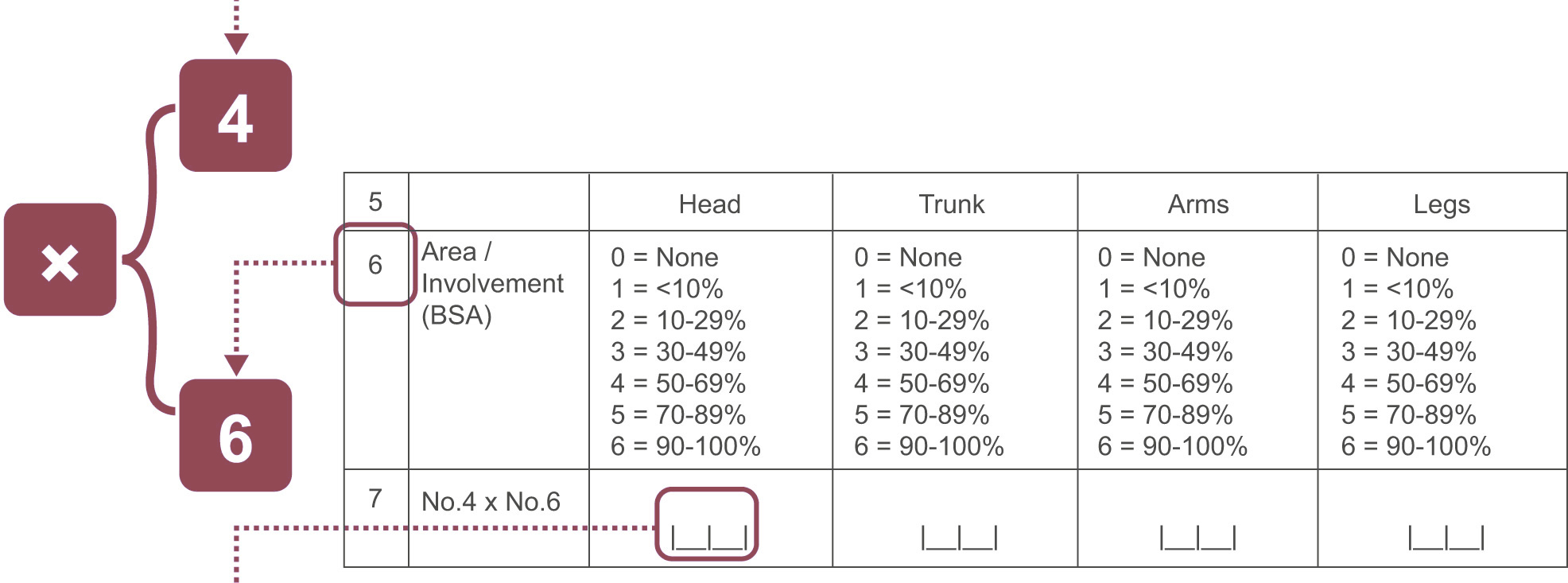Home
electronic Psoriasis Area Severity Index
ePASI
Psoriasis assessment made easy and quick
What is the ePASI?
The ePASI is a tool for dermatologists and physicians based on the Psoriasis Area Severity Index (PASI), which is available as a mobile application for Android and iOS devices and as a web-based online calculator. The PASI score reflects the severity of psoriasis and is used in experimental dermatology to assess the efficacy and safety of drugs used to treat psoriasis.
Validation of questionnaire
paper version: yes digital version: no
How to use the ePASI
ePASI assesses four body regions: i) the head and neck, ii) the hands and arms, iii) the chest, abdomen and back (trunk) and iv) the buttocks, thighs and legs. Each region is given a score based on the extent and severity of the psoriasis. The body surface affected by psoriasis can range from 0 (no psoriasis) to 6 (all of the skin affected). The severity score, based on redness, thickness and scaling, is rated from 0 (none) to 4 (very severe). The final score falls between the range of 0 (no psoriasis) to 72 (maximum psoriasis). The sum of the points per body region results in the total PASI score, which can range from 0 (no psoriasis) to 72 (highest psoriasis severity).
Instructions
First, a partial score is determined for all body regions according to the following criteria:

Partial score - head:
Values for redness, scaling and thickening on the head (sum between 0 and 16) multiplied by the affected surface area of the head (between 0 and 6) multiplied by 0.1.

Partial score - trunk:
Values for redness, scaling and thickening on the trunk (sum between 0 and 16) multiplied by the affected surface area of the trunk (between 0 and 6), multiplied by 0.3.

Partial score - arms:
Values for redness, scaling and thickening on the arms (sum between 0 and 16) multiplied by the affected surface area of the arms (between 0 and 6) multiplied by 0.2.

Partial score - legs:
Values for redness, scaling and thickening on the legs (sum between 0 and 16) multiplied by the affected surface area of the legs (between 0 and 6) multiplied by 0.4.
The addition of the four partial scores results in a total PASI score, which lies between 0 and 72 points.
Below is an example of the PASI calculation process in four steps.
1) Severity of psoriatic lesions
Please circle one number per body region for each of the following: erythema (redness), induration (thickness) and scaling. The severity is rated on a scale from 0 (none) to 4 (very severe).

2) Affected body surface area
For each body region, please note the area affected by psoriasis in line 6. Mark the corresponding numbers in front of the percentages.
Multiply the results from No. 4 with the number you chose in No. 6.

3) Calculate partial scores
Multiply the result you got in line 7 with the number in line 8. Each body region has a different number corresponding to that area. For the head multiply the result in line 7 with 0.1; for the trunk: x 0.3; for the arms: x 0.2; for the legs: x 0.4.

4) Calculate the total PASI score
Add up all the numbers in row 9 to get the final PASI score.

Want to know more?
Download the full PDF guide and access all text and visual tips for your PASI
calculations everywhere.
Want to know more?
Download the full PDF guide and access all text and visual tips for your PASI
calculations everywhere.
The following versions of the ePASI are available

Plate XXIII, Psoriasis. Crocker 1896
Credit: Wellcome Library, London
About Psoriasis
Psoriasis is a long-lasting autoimmune disease known by its abnormal patches of skin (red, itchy and even scaly).
“Psoriasis is a chronic inflammatory disease, with an incidence in Western industrialized countries of 1.5 % to 3 %. It represents a great burden to the patient due to marked loss of quality of life, therapy-refractory course and frequent side effects of therapy.”
Prof. Dr. med. Matthias Augustin
Features
USER-FRIENDLY
The design of the ePASI with pictures and descriptions makes filling out the tool easy to understand for both physicians and patients.
QUICK
Save time with our online tool. Fill in the questionnaire and your ePASI score will be calculated automatically.
WIDELY USED
The PASI is currently the most widely used tool to determine the severity of psoriasis.
MULTILINGUAL
The ePASI is available in different languages. The use of the respective first language reduces language barriers and supports the understanding between physician and patient.
ACCESSIBLE FROM ALL DEVICES
With DermaValue, your ePASI is always just a few clicks away. The application is available for PCs, tablets, smartphones, and other devices.
ENVIRONMENTALLY FRIENDLY
Take care of the environment and save your patient data on the online platform or as PDF files for yourself and your physicians.
Our partners
















